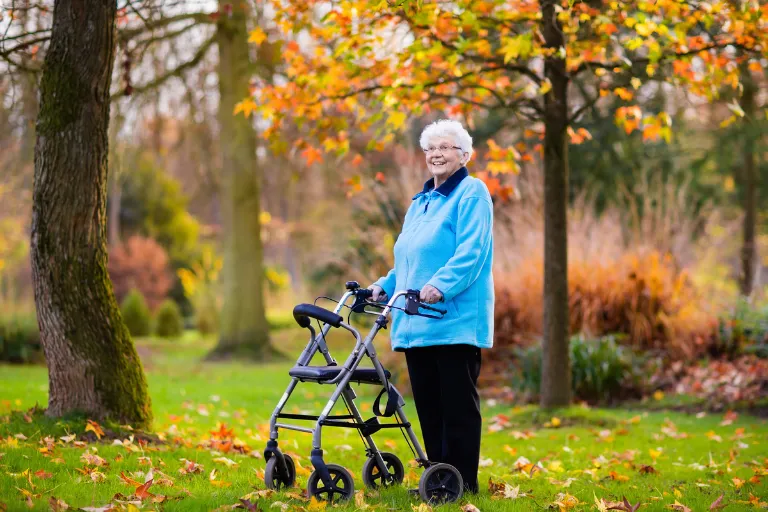Key Points
- Beyond mobility, these devices help restore confidence, encourage social participation, and support active aging.
- Modern walkers now include ergonomic designs, lightweight materials, and smart technology to enhance safety and independence.
- Studies show that advanced walkers can significantly reduce fall risk and improve quality of life for older adults.
Reclaiming Mobility: A Quiet Revolution in Aging
For decades, walkers were viewed as symbols of frailty—clunky metal frames that signified loss rather than freedom. But today, a new generation of mobility aids is changing that narrative. From carbon fiber frames that glide with ease to smart sensors that detect uneven ground, advanced walkers are giving older adults something invaluable: the confidence to move independently.
As the global population ages, the need for mobility support is growing fast. According to the World Health Organization, roughly one in three adults over 65 experiences a fall each year—a statistic that often triggers fear and reduced activity levels [1]. Innovations in walker design are helping to break this cycle by combining stability with empowerment, allowing seniors to stay active and socially engaged longer than ever before.
Why Advanced Walkers Matter
Mobility isn’t just about movement—it’s about freedom, confidence, and participation in life. Losing the ability to walk safely can lead to cascading effects: muscle weakness, isolation, and even depressive states. Traditional walkers, while functional, often came with limitations such as bulkiness, difficulty maneuvering, and poor ergonomics.
Modern walkers address these issues through thoughtful engineering:
- Ergonomic handles and adjustable heights reduce joint strain and promote better posture.
- Lightweight aluminum or carbon fiber frames make devices easier to transport.
- Built-in brakes and stability features increase user control and safety.
- Smart sensors and connectivity options (available in some high-end models) can track walking patterns, detect falls, and even alert caregivers [2].
The result? Older adults are moving with more confidence—and fewer interruptions to their daily lives.
The Science Behind Mobility and Safety
Mobility plays a direct role in health outcomes. Research shows that regular movement supports balance, cardiovascular function, and mental well-being among older adults [3]. Conversely, restricted mobility can accelerate cognitive decline and increase fall risk.
A 2023 review in Geriatric Rehabilitation Journal found that advanced mobility aids, particularly rollators with four wheels and ergonomic grips, improved gait performance and balance compared to standard frames [4]. Other studies highlight the psychological benefits—users report feeling more secure, less anxious, and more willing to leave home independently.
Health professionals emphasize proper fitting and training as critical components of safety. “An advanced walker is only as effective as its alignment with the user’s needs and abilities,” notes physical therapist Dr. L. Chen of Stanford Health Care [5]. Proper posture, wheel alignment, and brake control can make a measurable difference in stability and comfort.
Beyond Physical Support: Emotional and Social Benefits
Mobility challenges often bring invisible burdens—fear of falling, loss of autonomy, and social withdrawal. The right walker can counter these effects by restoring a sense of agency.
Users who adopt modern walkers often report feeling more self-sufficient and less dependent on caregivers. Studies from the Journal of Aging and Physical Activity indicate that improved mobility correlates with better mood and higher participation in community activities [6]. Being able to walk to the park, attend social gatherings, or shop independently helps preserve identity and dignity in aging.
The psychological uplift is just as important as the physical stability. A well-designed mobility device can shift the emotional tone of aging—from restriction to possibility.
Choosing the Right Walker
Not all walkers are created equal, and the best choice depends on individual needs and environments. Here are key factors to consider:
- Terrain: For outdoor use, large-wheeled rollators provide better shock absorption and stability.
- Strength and endurance: Lightweight frames suit those with limited upper-body strength.
- Storage and transport: Foldable designs are ideal for travel or smaller living spaces.
- Features: Look for padded seats, adjustable grips, and reliable braking systems for safety.
Consulting a health professional ensures proper fit and alignment, reducing risk of strain or imbalance. Certified models that meet U.S. FDA and European CE safety standards offer additional peace of mind.
Looking Ahead: The Future of Mobility Aids
The next frontier in walker innovation merges biomechanics and digital intelligence. Engineers are experimenting with robotic-assisted walkers that can sense terrain and adjust support in real-time [7]. Some prototypes even use artificial intelligence to detect changes in gait that may signal fall risk or early signs of neurological decline.
As these technologies advance, mobility devices will become less about assistance and more about partnership—helping older adults live with greater independence and health.
Empowering Movement, Restoring Confidence
For many older adults, walking again without fear is more than a goal—it’s a return to life itself. Advanced walkers are helping to make that possible, not through complex technology alone, but by respecting the basic human desire for freedom and dignity in motion.
Medical Disclaimer:
This article does not in any way constitute medical advice. Please seek consultation with a licensed medical professional before starting any therapy. This website may receive commissions from links or products mentioned in this article.
Subscribe for Free for more insightful health articles tailored to your needs.
Sources
- World Health Organization. Falls: Key Facts. (2023).
- U.S. Food & Drug Administration. Guidance on Mobility Aids and Assistive Devices. (2022).
- American Geriatrics Society. Mobility and Aging: Functional Implications. (2023).
- Journal of Geriatric Rehabilitation. (2023). Comparative Study on Advanced Mobility Aids and Balance Outcomes.
- Chen, L. (2023). Walker Fit and Posture Optimization in Senior Populations. Stanford Health Care.
- Journal of Aging and Physical Activity. (2022). Mobility, Confidence, and Social Engagement Among Older Adults.
- Nature Biomedical Engineering. (2024). AI-Enhanced Robotic Walkers for Assisted Mobility.
Last Updated on October 22, 2025



